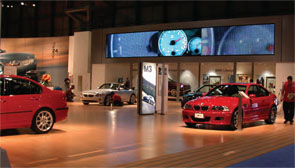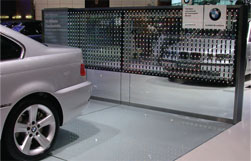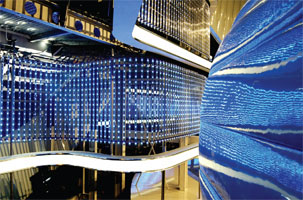The Long-Touted Convergence Of Lighting And Video Has BegunWhen Radiohead decided to deploy LEDs as the exclusive light source for their 2008 “In Rainbows” tour, they set a precedent that seems likely to have many followers. Ostensibly,
Far from being disdained for its low image resolution, the highly pixellated effect created by low-res LED walls is considered desirable in applications such as auto shows and TV studios, where it creates a dynamic backdrop without detracting attention from the subject matter. the band’s decision to go ‘bulb-free’ derived from a desire to reduce the tour’s carbon footprint; the tour’s lighting design reportedly used two-thirds less power than its 2003 equivalent.
Yet there was also a creative impetus at work which, if anything, has broader implications for the professional AV community than the drive to cut energy consumption. The people responsible for the tour’s look saw themselves as visual designers, not lighting designers. And much of the technology used—not least the low-res LED videowalls provided by Element Labs—has more in common with the AV space than it does with the traditional theater or show lighting industry.

A device commonly used by the auto industry is that of embedding high-res LED screens within low-res ones, where the latter present a graphical counterpoint to the main, full-motion image. with no video signal being present at all.
“If you look at concerts, there are some that only use video, and some that only use lighting, but the majority of them have some mixture,” Nelson pointed out. “The rental agencies who are our customers don’t want to have to deal with a lot of different controller products. So they like the idea of being able to just put up a screen or a surface that works as lighting and then, at the flip of a switch, also produces video.”
OFF-STAGE
It was rental companies that were the early adopters of low-resolution LED technology, using it for everything from rock concerts to auto shows and corporate events. Yet as the cost of the technology has fallen, the systems integrator channel has become a market player and may, in fact, be responsible for most of its future growth. Barco, which makes both high-res and low-res LED panels, explicitly recognized this trend last fall, when it formed its new Video and Lighting Integration (VLI) business unit, a global entity purpose- designed for systems contractors to meet the increasing demand for integrated solutions in the fixed installation space.
“Going with the integrator channel gives us a real expansion opportunity, because their reach is far beyond anything that we could achieve with our own sales team,” commented Dana Corey, vice president, Video and Lighting Integration at Barco. “And as well as potential for growth, integrators also add, from the technical side, knowledge of how the other elements in an AV system link together. Our biggest challenge will be to educate the channel so that can creatively deliver some of the things that rental people achieve.”
Corey added that, from a creative point of view, Barco often sees “the migration of an idea from a concert tour that lasts three months to an installation that lasts years”, and that trend seems certain to gather momentum.
Yet it’s a curious fact in the evolution of low-res LED walls that the technology’s original catalyst came from the architectural field, rather than entertainment. Peter Ed, business development consultant at GLEC, traces the story back to the late 1990s, when Panasonic was asked to create a giant screen for
you could move around and behind’, and so made their low-res LED display products transparent. the façade of a nine-storey department store in the Shibuya district of Tokyo. The screen had to be transparent to allow daylight to pass through the windows of shops and restaurants, necessitating the separation of the drivers and electronics from the LEDs themselves.
“One of the most important aspects of our screens is their transparency,” Ed explains. “From the beginning, GLEC envisaged taking images out of the 2D format, having video that you could walk through and behind. It has an almost theatrical feel and, in an environment such as an auto show, it acts as a perfect ‘reveal’.”
Separating the LEDs from their drive electronics has historically been a technical challenge. When these screens are showing video, refresh rates are high and there is no scope for any latency because each tile has to be completely in sync with all the others. The screens need a lot of signals delivered to them at high speed, and the longer the cable runs, the harder this is to achieve. Ed believes, however, that today’s products have evolved to the point where they are much easier to deploy reliably.
MOVING AHEAD
LED walls are not the only technology sector to witness convergence between the worlds of lighting and video. Last year Barco launched its DML1200 ‘Digital Moving Light’, which combines the functions of moving-head light and video projector in a single fixture, then added substantially to its portfolio of lighting designer-friendly products by acquiring High End Systems, pioneers of the ‘moving-head projector’. Barco’s Dana Corey believes that the economic situation will speed convergence even further.
“In the world of fixed installations, there is work out there but it’s going to be all about budget,” Corey said. “Take the [High End] DL3 or the DML1200, products that can be both a light and a projector, and there’s a clear advantage. It’s about more for less.”
Element Labs’ Barbara Nelson agrees that it is the versatility of ‘converged’ technology that may hasten its adoption by end customers, not just in rental but in architectural applications as well. “The people who own a building, the people actually buying the technology, can see the commercial advantage of a product that can do two things. You can put creative lighting on the side of a building, but it’s better if it has the capability to run a video show so that the building becomes an extension of your brand.”
The question now, for both rental and architectural sectors, is whether the AV community can retain its level of influence, or even increase it, in the face of competition from lighting professionals. In rental, it seems that the increased ease of use of modern LED wall products might favor the lighting guy. Things are less clear-cut in the installation space, with Nelson stressing that the company’s new control platform, with image processing, data, and power distribution all managed through Element Labs’ proprietary software, will be common to all future products: “That will soften the learning curve for the integrator. Once you’ve learned one platform, you’ve learned them all.”
More generally, Corey pointed out that if an AV company fails to grasp the opportunity that convergence with lighting offers, then somebody else will. “In today’s economy,” Corey concluded, “you can’t have a multitude of specialists. You have to have people who specialize in a lot of different areas, controlling the signal all the way from the content to the display—or to the lights.”

